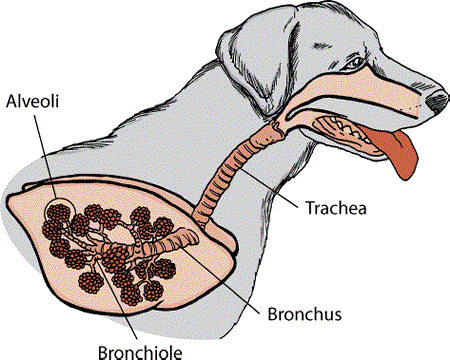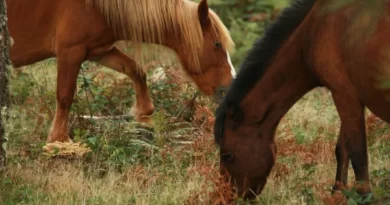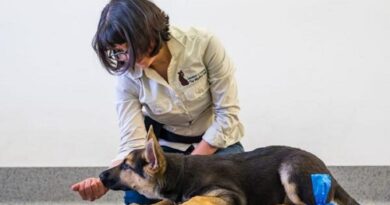Dog’s Respiratory System
Dog's Respiratory System
The dog’s respiratory system is very similar to that of humans . Like ours, we can divide it into an upper respiratory tract, which goes from the nose to the trachea, and a lower respiratory tract, from the trachea to the lungs.

Dog breathing type
Breathing is a fundamental function for all living beings, although not all carry it out in the same way. As we have said, it is based on exchanging oxygen for carbon dioxide . Through breathing, the oxygen present in the external environment is obtained and, in exchange, the carbon dioxide that would be toxic if it remained in the body is eliminated.
To carry out this exchange, living beings have developed different types of respiration, such as gill breathing , characteristic, for example, of many fish, in which gas exchange takes place in the gills. Tracheal respiration is common in insects and we could still talk about another type of respiration, skin respiration , in which gas exchange occurs on the surface of the skin. It is a common breath in amphibians. But how do dogs breathe? They, like us, have lung-type breathing., exchanging oxygen for carbon dioxide in the lungs. The ribs, the chest musculature and the diaphragm help breathing by working as a kind of «bellows» to facilitate the inspiration and expiration of air.
The respiratory rate considered normal in a healthy adult dog is 24 breaths per minute at rest, with a wide range of variation, within normality, between 10 and 30 breaths.
Parts of the dog’s respiratory system
As we have said, the dog’s respiratory system can be divided into upper and lower. Broadly speaking, the upper respiratory tract comprises the nose, pharynx, and larynx. For its part, the lower respiratory tract is made up of the bronchi and lungs. The trachea connects both tracts. We look at each of these elements in more detail:
- Nose : it is formed by the nostrils and the nasal cavity, divided into two nostrils, which lead to the throat. The maxillary and frontal sinuses connect with the nasal cavity. The mucosa of this cavity constitutes a defense against pathogens and irritants.
- Pharynx : It is the junction area between the nasal passages and the back of the mouth. This is where the epiglottis valve (like a cartilaginous flap) is located, in charge of closing the larynx when the dog swallows to prevent any element from passing into the respiratory tract.
- Larynx – Arranged above the trachea and below the epiglottis, it is composed of cartilage. In it we locate the vocal cords. Its interior is covered with a mucosa without cilia, which hinders the mobility of the mucus, which can end up adhering to it. It is easy for any pressure to trigger a cough. We can see an example in dogs that wear a collar and pull. They will soon begin to cough.
- Trachea : it is a tube with C-shaped cartilage rings, which allows it to maintain its shape and allow the free passage of air without collapsing. It goes from the larynx to the main bronchi, which carry air to the lungs.
- Bronchi : the main or primary bronchi (left and right) are divided into secondary bronchi, which, in turn, are subdivided into increasingly narrow ducts until they reach what are called bronchioles. They can be larger or smaller. In those of smaller caliber, the pulmonary alveoli are formed, also called alveolar sacs, where, as we have said, gas exchange finally occurs.
- Lungs : are two air-filled, elastic, spongy organs located in the chest cavity and protected by the ribs. We will talk about them in more detail in the following sections.
How many lungs do dogs have?
As we have said, dogs breathe thanks to their lungs. Specifically, they have two lungs , the left and the right, which are divided into lobes by deep fissures. They are connected to each other and covered by a membrane known as the «pleura». They are located in the pleural cavities between which is the mediastinum.
Dog Lungs Anatomy
The internal structure of the lungs is reminiscent of a tree , since different ramifications are produced in them, from larger to smaller size, from the division of the trachea to the alveoli. Thus, the lungs are made up of the bronchi , bronchioles and alveoli , which are, ultimately, the place where gas exchange occurs, as we have already mentioned. In them oxygen passes into the blood and carbon dioxide leaves thanks to a pressure difference.
The first branch of the trachea is made up of the main bronchi, the left and the right, which divide into lobar bronchi. This is so because the lungs are divided into lobes. We will find two in the left lung (cranial and caudal) and four in the right (cranial, middle, caudal and accessory).
Tips to maintain the dog’s respiratory system
Health problems involving the respiratory system can become serious, compromising the dog’s breathing and, therefore, its life. Some will be unpredictable, but others we can control taking into account measures such as the following:
- See your vet at any sign of illness, such as runny nose, coughing, or difficulty breathing.
- Avoid going through places with spike-type elements that the dog can inhale when sniffing. Also, do not allow him to travel with his head outside the car window.
- Be careful with security . It is important that the dog does not have access to foreign bodies that may remain lodged in its respiratory tract.
- Do not expose it to contaminants such as smoke or tobacco, as they cause, at least, irritation. Try to properly ventilate the house.
- Keep the schedule of deworming and vaccinations prescribed by the veterinarian. It is important to prevent the presence of pulmonary parasites and respiratory diseases.
- Try to keep it at its optimal weight . Extra kilos, be it overweight or obesity, make it difficult to breathe and, in general, reduce the quality and life expectancy. They are not just an aesthetic problem.
- Use a harness better than a collar so as not to damage the trachea.



